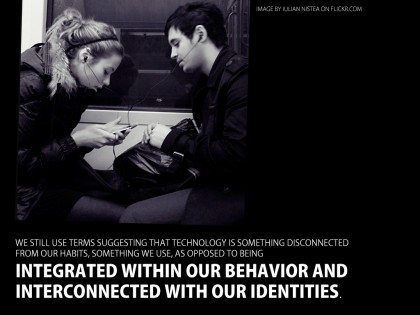In an interesting panel at the Webdagene conference last week, one of the panelists, Erik Hafner Rønjum, wanted a discussion in regards to what “mobile” was.
Holding up his iPhone, iPad and laptop, saying that he used them all on the go, and as their size and portability really didn’t make that much of a difference – could some, or all of them be categorized as mobile?
As far as I gathered the panel did not answer this question, but I find it valid as it implies that our vernacular is already outdated. And, that we, in order to understand the implications and effect of technology on our everyday life, need to keep updating our language
.
We still use terms suggesting that technology is something disconnected from our habits, something we use, as opposed to being integrated within our behavior and interconnected with our identities
. As Kevin Kelly suggest in regards to the alphabet:
- “If we think about the dependency we have on this other technology, called the alphabet, and writing, we are totally dependent, it’s transformed culture. We cannot imagine ourselves without the alphabet and writing. And so in the same way we are going to imagine ourselves without this other machine being there.” – Kevin Kelly

What is mobile?
It’s not about the platform or technology its about the context. And when we differentiate by context, mobile as a concept, and a device, fragments into a range of scenarios: from interacting with the barcodes in a shop, to checking the bus schedule on your way to the station, playing games hours on end or spending 10 minutes reading through an article on Instapaper.
Initially mobile was about immediacy, vs. the PC which was about everything else. Then we added laptops, notebooks, handhelds, tablets and iPads to the equation. As every piece of personal computational hardware has gone portable the stereotypical use situations differentiating devices have been washed out.
There are at least two possible answers to the question:
- 1
. The first one is that ‘mobile’ as a term still applies. Something that is important because it allows people outside our vernacular to actually join in and understand the discussion
management• Ejaculation How long does cialis take to work?.
.
Mobile would then be connected to its use
. Simplifying it we could suggest that mobile is anything not needing people to sit and/or support the device on their lap. Or to put it in other words – mobile is “on the go”.
The interesting question that arises from this is then that the smart phone is a mobile when used on the bus, but stationary when used on the couch at home? This introduces the second answer – there is no mobile.
2. Mobile as a term no longer exists
. Because there is no dividing line between which devices are used where and for what, it’s all blurred. When designing for different platforms, what we need to think about is the need for stuff like: screen real estate, time, focus, enjoyment, tasks, information, type of human interaction, immediacy, role, tactile etc.
We need to define the activity based on its preferences, not the connected ability of the device we are putting it on – because everything is connected and portable.
If mobile as a term is getting difficult to understand now, its not getting better. The term will likely, as we approach the reality described by Kevin Kelly, become meaningless – everything will be “mobile”.
Which raises the question: is there any point to the discussion of what mobile is, as it already has lost its ability to specify any useful ability of an object or application?
I’ve at the end here added the mobile abilities map presentation introducing some ideas to what mobile / the mobile mindset should be focused towards.


Yes, the term is meaningless, but it’s the only one we’ve got. :-)
Mobile is a context. Casual computing on the couch is another, but related context.
The next few years will be a time where the traditional PC will turn into a specialized office device used by few. Like Silicon Graphics Workstations back in the days.
Let’s invent a new term. Something along the lines of “always connected devices”. And how we must design for contexts.
Hi Jonas, thank you for your comment.
We agree. But are you still thinking in the lines of defining terminologies based on technology: “always connected devices” and then design according to context? Wouldn’t it be best if both terminology and design follow the same direction, which we agree on is context?
Best
Helge
Yes. context is the direction, but the technology sets the limitations of what we can do. And right now those limits are being expanded every day. I think we need some new words to describe these technologies. Something other than “computer” and “mobile”. :-)
“Fundamentally, “mobile” refers to the user, and not the device or the application” – Barbera Ballard
mobile is part of communication one persion to another persion .
mobile ia a source of communication.it is hidden communication gape between one person to another person.it is a hardware.
And I thought mobile meant “not physically connected via ethernet cable”? As soon as you’re using some sort of Wi-Fi, you’re mobile?